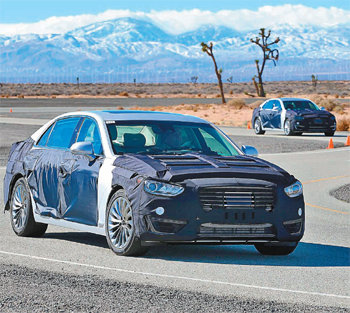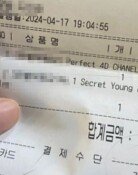Genesis EQ900 aims for the U.S. market
Genesis EQ900 aims for the U.S. market
Posted November. 23, 2015 08:58,

The Dong-A Ilbo visited the Hyundai-Kia Motors California Proving Ground, which is over two hours far away by bus from downtown Los Angeles, California, on last Tuesday (local time). The proving ground located in the Mojave Desert has an area of 17.7 million square meters, six times larger than Yeouido, Seoul. Hyundai Motor built this proving ground in 2005 at 65 billion won (5.62 billion dollars).
In the field was EQ900, the luxurious flagship sedan of Hyundai Motor. Scars were visible through the car`s cover that is for masking the car`s design; a result of the intense road testing process. The car looked like a gladiator who has long prepared for a battle.
○ Backseat with less vibration and a more comfortable ride
The trial ride in the backseat was done in three ways. On both the common fan shape road and a portion of the high speed road, the reporter team experienced a speed of over 200km/h. On the EQ900 equipped with a Lambda 3.3 V6 Turbo Engine, the reporter felt as if he was being pressed downward by the speed. On the testing road for high-speed control stability, the car made a steep curve at more than 100 kilometers per hour. The reporter`s body slid to one side as the car leaned outward, but the backseat seemed to secure the reporter`s body tightly.
The proving ground has a mock L.A. freeway field with detailed features of California highways. Many highways in the L.A. area were built with concrete plates that have a curvy surface. For this reason, foreign car manufacturers targeting the U.S. market have been focused on finding an optimal tuning to minimize the shock from the road surface.
After a few trial rides in the Mercedes Benz S550 and Lexus LS460 to compare with EQ900, the reporter team recognized just how hard Hyundai Motor has been working to reduce the vibration. Comparing to the EQ900, the S550 seemed to have about the same vibration level and the LS460 had a higher vibration level.
"Normally, when a new car is released, the development team tends to avoid comparing trial rides with their rival cars. This time, however, the team allowed it and that means they are confident," said an officer at Hyundai Motor.
○ Road test for 100,000 miles in areas of severe heat and cold
The Genesis EQ900 kept its balance when a professional driver was steering at over 80 kilometers per hour and then turned the wheel 270 degree without the brake. The auto emergency braking (AEB) test with a mannequin was also successful. AEB is a function that automatically stops the car when a pedestrian appears in front of the car when it is driving at a low speed.
The EQ900 went through tests outside the proving center as well, in the severe heat of Death Valley where the average temperature goes up to 49 degrees Celsius and in the severe cold of Alaska along with other various places. In the U.S. alone, the road test continued for over 100,000 miles. This distance is over 20,000 miles longer than the Genesis DH, the second generation of the Genesis released in 2013.
EQ900 project manager Kim Sung-soo said, "In order to make it realistic in the Korean customers` view, we conducted road tests on all kinds of roads in Korea including downtown areas and the mountains of Gangwon Province." Hyundai Motor plans to release the EQ900 in Korea this December and sometime between July and December, 2016 in the U.S. with a different name, the G90. The company aims at selling at least 16,000 units in Korea and 5,000 units of Genesis EQ900 in the U.S.
mint4a@donga.com







